Acids Study guides, Class notes & Summaries
Looking for the best study guides, study notes and summaries about Acids? On this page you'll find 33509 study documents about Acids.
Page 238 out of 33.509 results
Sort by
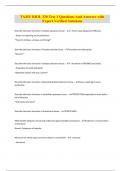
-
TAMU BIOL 320 Test 1 Questions And Answers with Expert Verified Solutions
- Exam (elaborations) • 21 pages • 2024
-
- $9.99
- + learn more
Describe the basic functions of simple squamous tissue. - - Areas requiring passive diffusion - Areas not requiring much protection *Found in kidneys, serosae, and linings* Describe the basic functions of simple cuboidal tissue. - Secretion and absorption *Ovaries* Describe the basic functions of simple collumnar tissue. - - Secretion of ENZYMES and lubes - Propulsion of stuffs (cilliated) *Digestive system and resp. system* Describe the basic functions of pseudostratified collumnar tiss...
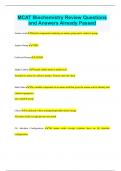
-
MCAT Biochemistry Review Questions and Answers Already Passed
- Exam (elaborations) • 109 pages • 2023
-
- $11.99
- + learn more
Amino Acid Dipolar compound containing an amino group and a carboxyl group Amino Group -NH2 Carboxyl Group -COOH Alpha Carbon Central carbon atom in amino acid Attached to amino & carboxyl groups, H atom, and side chain Side Chain The variable component of an amino acid that gives the amino acid its identity and chemical properties also called R-group Chiral A molecule with a nonsuperimposable mirror image All amino acids (except glycine) are chiral (S) Absolute Configuration All amino...
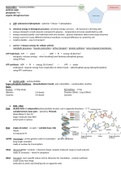
-
WJEC (England) Eduqas Biology A-Level Core Concepts - 5. Nucleic Acids
- Summary • 4 pages • 2023
-
Available in package deal
-
- $3.82
- + learn more
I achieved a high A* Grade in my final A-Level exams using these notes!!! I believe you can achieve an A* if you can memorise these notes! Simply use blurting, a method of active recall, to write everything you remember from the notes, then identify the parts you couldn’t remember, then repeat until you can remember it all! If you can do that, you’ve got an A* in the bag! They are clear, concise, and are laid out according to the specification; there is no information missing or in excess...
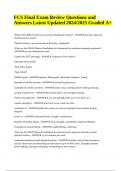
-
FCS Final Exam Review Questions and Answers Latest Updated 2024/2025 Graded A+ | Verified.
- Exam (elaborations) • 35 pages • 2024
- Available in package deal
-
- $14.99
- + learn more
FCS Final Exam Review Questions and Answers Latest Updated 2024/2025 Graded A+ | Verified. What is the different between exercise and physical activity? - ANSWER Exercise- planned, intentional movement Physical activity- any movement of the body, unplanned What are the DHHS Physical Guidelines for Americans for moderate-intensity workouts? - ANSWER 150-300 minutes per week Explain the FITT principle - ANSWER Frequency (How often?) Intensity (How hard?) Time (How long?) Type (what?) SMAR...
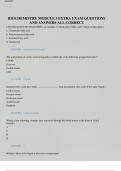
-
BIOCHEMISTRY MODULE 5 EXTRA EXAM QUESTIONS AND ANSWERS ALL CORRECT CH3(CH2)4CH=CH(CH2)6COOH is an example of which type of fatty acid? (check all that apply) a. Unsaturated fatty acid b. Polyunsaturated fatty acid c. Saturated fatty acid d. Cholesterol A
- Exam (elaborations) • 7 pages • 2023
-
Available in package deal
-
- $12.49
- + learn more
BIOCHEMISTRY MODULE 5 EXTRA EXAM QUESTIONS AND ANSWERS ALL CORRECT CH3(CH2)4CH=CH(CH2)6COOH is an example of which type of fatty acid? (check all that apply) a. Unsaturated fatty acid b. Polyunsaturated fatty acid c. Saturated fatty acid d. Cholesterol ANSWER - unsaturated fatty acid The acid portion of a fatty acid corresponds to which one of the following groups/molecules? COOH Glycerol Double bonds CH3 ANSWER - COOH Saturated fatty acids have more _________________ than unsatu...
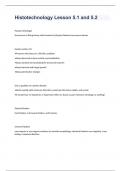
-
Histotechnology Lesson 5.1 and 5.2 question n answers graded A+
- Exam (elaborations) • 6 pages • 2023
- Available in package deal
-
- $12.99
- + learn more
Histotechnology Lesson 5.1 and 5.2Fixation (histology) the process of fixing tissues with chemical of physical fixatives to preserve tissues Fixative actions (5) •Preserves the tissues in a life-like condition •Stops abnormal enzyme activity and metabolism •Stops autolysis by inactivating the lysosomal enzymes •Stops bacterial and fungal growth •Stops putrefactive changes Give 2 qualities of a perfect fixative •Works quickly with minimum distortion, penetrate the tis...
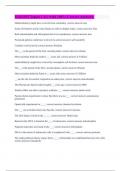
-
WIS2552 Topics 1-8 || with 100% Correct Answers.
- Exam (elaborations) • 15 pages • 2024
-
Available in package deal
-
- $11.89
- + learn more
Multicellularity might have evolved from coloniality. correct answers true Some of Pasteur's sterile water flasks are still on display today. correct answers True Both mitochondria and chloroplasts have two membranes. correct answers true Protenoid spheres could have evolved via correct answers self assembly Conifers evolved in the correct answers Permian The ___ is the period of the first vascular plants. correct answers silurian Most scientists think the earth is ___ years o...
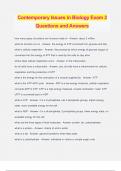
-
Contemporary Issues in Biology Exam 2 Questions and Answers
- Exam (elaborations) • 24 pages • 2024
-
- $13.49
- + learn more
Contemporary Issues in Biology Exam 2 Questions and Answers how many types of proteins are humans made of - Answer- about 2 million what do humans run on - Answer- the energy of ATP converted from glucose and fats what is cellular respiration - Answer- the process by which energy of glucose (sugar) is converted into the energy of ATP that is used by the cells to stay alive where does cellular respiration occur - Answer- in the mitocondria do all cells have a mitocondria - Answer- yes, all...
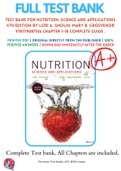
-
Test Bank For Nutrition: Science and Applications 4th Edition By Lori A. Smolin; Mary B. Grosvenor 9781119087106 Chapter 1-18 Complete Guide .
- Exam (elaborations) • 140 pages • 2023
-
- $27.36
- + learn more
Test Bank For Nutrition: Science and Applications 4th Edition By Lori A. Smolin; Mary B. Grosvenor 7106, 4 . 4693, 1 1: Nutrition: Food for Health 2: Nutrition Guidelines: Applying the Science of Nutrition 3: Digestion, Absorption, and Metabolism 4: Carbohydrates: Sugars, Starches, and Fiber 5: Lipids: Triglycerides, Phospholipids, and Cholesterol 6: Proteins and Amino Acids 7: Energy Balance and Weight Management 8: The Water-Soluble Vitamins 9: The Fat-Soluble Vitami...

-
MTTC Integrated Science Exam with Complete Solutions
- Exam (elaborations) • 22 pages • 2023
- Available in package deal
-
- $12.99
- + learn more
Independent Variable - ANSWER-The experimental factor that is manipulated; the variable whose effect is being studied. Placed on the x-axis (horizontal) on a graph. Dependent Variable - ANSWER-The variable that is measured in an experiment. Placed on the y-axis (vertical) on a graph. Scientific theory - ANSWER-Must be repeatable. Possible to be disproved and capable of change. Sampling and Sample Size - ANSWER-Random sampling is the preferred, but isn't always possible. A large sample ...
-
1
- ...
-
237
-
238
-
239
- ...

Did you know that on average a seller on Stuvia earns $82 per month selling study resources? Hmm, hint, hint. Discover all about earning on Stuvia


